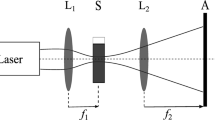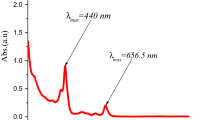Abstract
Chinese tea is the most highly consumed beverage globally. Its different types exhibit a strong nonlinear optical response as probed previously by Z-scan technique at various time scales. In this work, infusions of commercially available black, green, and white Chinese teas, prepared by running one cycle of a Soxhlet extraction, were studied by spatial self-phase modulation of a CW laser; each sample was found to have a different nonlinear refractive index n2, which can be used to distinguish these teas.




Similar content being viewed by others
References
M. Sheik-Bahae, A.A. Said, T.H. Wei, D.J. Hagan, E.W. Van Stryland, . IEEE J. Quantum Electron. 26, 760–769 (1990)
Y.F. Zhang, T. Miyoshi, N. Matsuo, Time-resolved Z-scan transmittance of Chinese tea. J. Lumin. 72-74, 557–558 (1997)
R.A. Ganeev, G.S. Boltaev, R.I. Tugushev, T. Usmanov, Investigation of nonlinear optical properties of various organic materials by the Z-scan method. Opt. Spectrosc. 112, 906–913 (2012)
Y.M. Cheung, S.K. Gayen, Optical nonlinearities of tea studied by Z-scan and four-wave mixing techniques. J. Opt. Soc. Am. B. 11, 636–643 (1994)
J.G. Tian, C. Zhang, G. Zhang, J. Li, Position dispersion and optical limiting resulting from thermally induced nonlinearities in Chinese tea liquid. Appl Opt. 32, 6628–6632 (1993)
S. Roshanak, M. Rahimmalek, S.A.H. Goli, Evaluation of seven different drying treatments in respect to total flavonoid, phenolic, vitamin C content, chlorophyll, antioxidant activity and color of green tea (Camellia sinensis or C. assamica) leaves. J. Food Sci. Technol. 53, 721–729 (2016)
E.A.H. Roberts, R.F. Smith, Spectrophotometric measurements of theaf lavins and thearubigins in black tea liquors in assessments of quality in teas. Analyst. 86, 94–98 (1961)
P. L. Fernández, M. J. Martín, A. G. González, F. Pablos, HPLC determination of catechins and caffeine in tea. Differentiation of green, black and instant teas. Analyst. 125, 421–425 (2000)
L.C. Kerio, F.N. Wachira, J.K. Wanyoko, M.K. Rotich, Characterization of anthocyanins in Kenyan teas: Extraction and identification. Food Chem. 131, 31–38 (2012)
A. Dankowska, W. Kowalewski, Tea types classification with data fusion of UV–Vis, synchronous fluorescence and NIR spectroscopies and chemometric analysis. Spectrochim. Acta. 211, 195–202 (2019)
A. Palacios-Morillo, A. Alcázar, F. de Pablos, J.M. Jurado, Differentiation of tea varieties using UV–Vis spectra and pattern recognition techniques. Spectrochimica Acta Part A:, Molecular and Biomolecular Spectroscopy. 103, 79–83 (2013)
J.X. Cai, Y.F. Wang, X.G. Xi, H. Li, X.L. Wei, Using FTIR spectra and pattern recognition for discrimination of tea varieties. Int. J. Biol Macromol. 78, 439–446 (2015)
J. Li, B. Fu, D. Huo, C. Hou, M. Yang, C. Shen, H. Luo, P. Yang, Discrimination of Chinese teas according to major amino acid composition by a colorimetric IDA sensor. Sensor Actuat. B-Chem. 240, 770–778 (2017)
J. Ning, J. Sun, S. Li, M. Sheng, Z. Zhang, Classification of five Chinese tea categories with different fermentation degrees using visible and near-infrared hyperspectral imaging. Int. J. Food Prop. 20, S1515–S1522 (2017)
F. Simoni. Nonlinear optical properties of liquid crystals and polymer dispersed liquid crystals (World Scientific, Singapore, 1997). papes 53–54 and 71–73
M.S. Ribeiro, R.F. Turchiello, S. L. Gómez, Employment of laser beam self-phase modulation for detecting adulterations in light-absorbing commercial fluids. Food. Anal. Method. 12, 908–913 (2019)
M.D. Luque de Castro, L.E. García Ayuso, in Soxhlet extraction. Encyclopedia of separation science, ed. by Ian D. Wilson (Academic Press, 2000), pp. 2701–2709
F.L.S. Cuppo, A.M. Figueiredo Neto, S.L. Gómez, P.P. Muhoray, Thermal-lens model compared with the Sheik-Bahae formalism in interpreting Z-scan experiments on lyotropic liquid crystals. J. Opt. S.c. Am. B. 19, 1342–1348 (2002)
R.F. Turchiello, L.A.A. Pereira, S.L. Gómez, Low-cost nonlinear optics experiment for undergraduate instructional laboratory and lecture demonstration. Am. J. Phys. 85, 522–528 (2017)
M.S. Ribeiro, K.C. Ribeiro, V.M. Lenart, R.F. Turchiello, S.L. Gómez, Low-cost nonlinear optics experiment for undergraduate instructional laboratory and lecture demonstration: A second experiment. Am. J. Phys. 88, 102–107 (2020)
H. Cabrera, J. Akbar, D. Korte, I. Ashraf, rez-Miquet Ramí E.E., E. Marín, J. Niemela, . Appl. Spectrosc. 72, 1069–1073 (2018)
C.L. Gomes, A.C.A. Lima, M. C. L. Cândido, A.B.R. Silva, A.R. Loiola, R.F. Nascimento, Multivariate analysis of perfumes by ultraviolet spectrophotometry. J. Braz. Chem. Soc. 26, 1730–1736 (2015)
R. Karimzadeh, Spatial self-phase modulation of a laser beam propagating through liquids with self-induced natural convection flow. J. Opt. 14, 095701 (2012)
H.J. Zhang, J.H. Dai, P.Y. Wang, L.A. Wu, Self-focusing and self-trapping in new types of Kerr media with large nonlinearities. Opt. Lett. 14, 695–696 (1989)
K.E. Peiponen, R. Uma Maheswari, T. Jaaskelainen, C. Gu, Demonstrating nonlinear optical phenomena with Chinese tea. Am. J. Phys. 61, 937–938 (1993)
M. Lai, J.C. Diels, Thermal nonlinear effects in exotic media: application to the study of nonlinear interfaces. Appl. Opt. 29, 3882–3885 (1990)
Acknowledgments
We are appreciative of the technical support of C-LABMU (UEPG).
Funding
The authors received financial support from the INCT-FCx, and the Brazilian agencies CNPq, CAPES, and Fundação Araucária.
Author information
Authors and Affiliations
Corresponding author
Ethics declarations
Conflict of Interests
The authors declare that they have no conflict of interest.
Additional information
Publisher’s Note
Springer Nature remains neutral with regard to jurisdictional claims in published maps and institutional affiliations.
Rights and permissions
About this article
Cite this article
de Souza, D.L.M., Bittencourt, M.V.G., Lenart, V.M. et al. Nonlinear Optical Response of Chinese Teas Probed by Spatial Self-Phase Modulation. Braz J Phys 50, 394–398 (2020). https://doi.org/10.1007/s13538-020-00756-9
Received:
Published:
Issue Date:
DOI: https://doi.org/10.1007/s13538-020-00756-9




